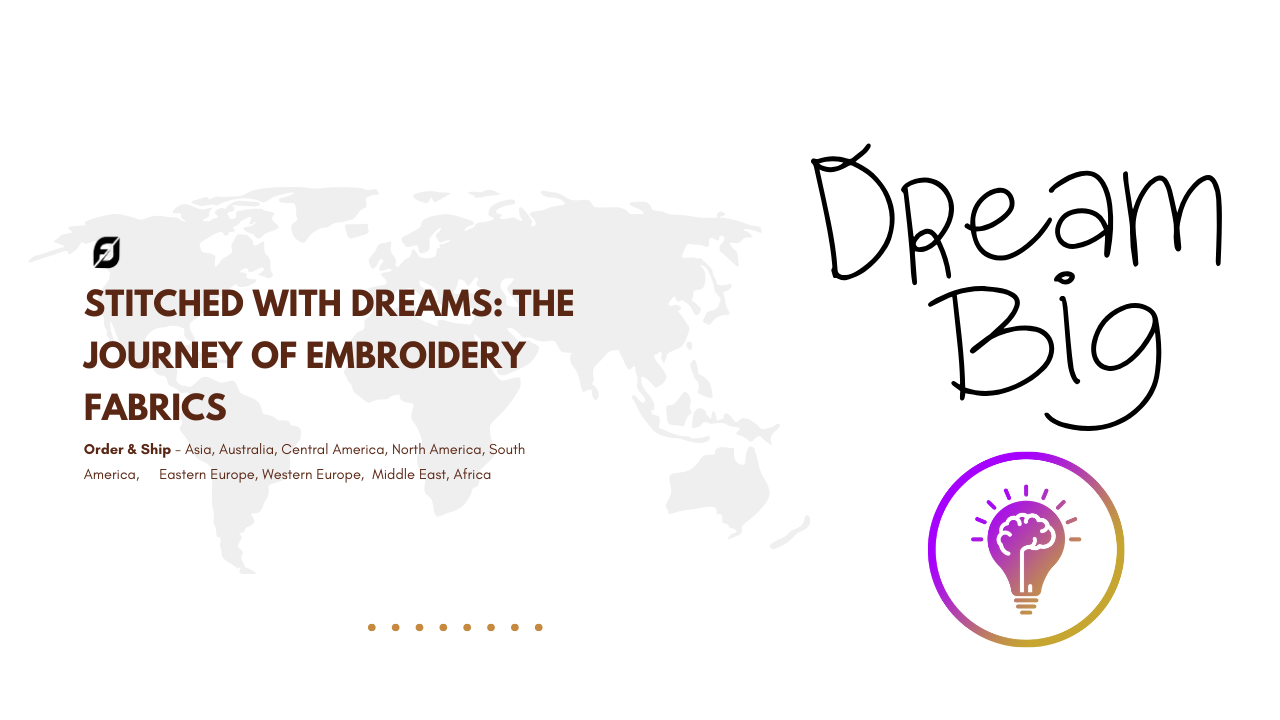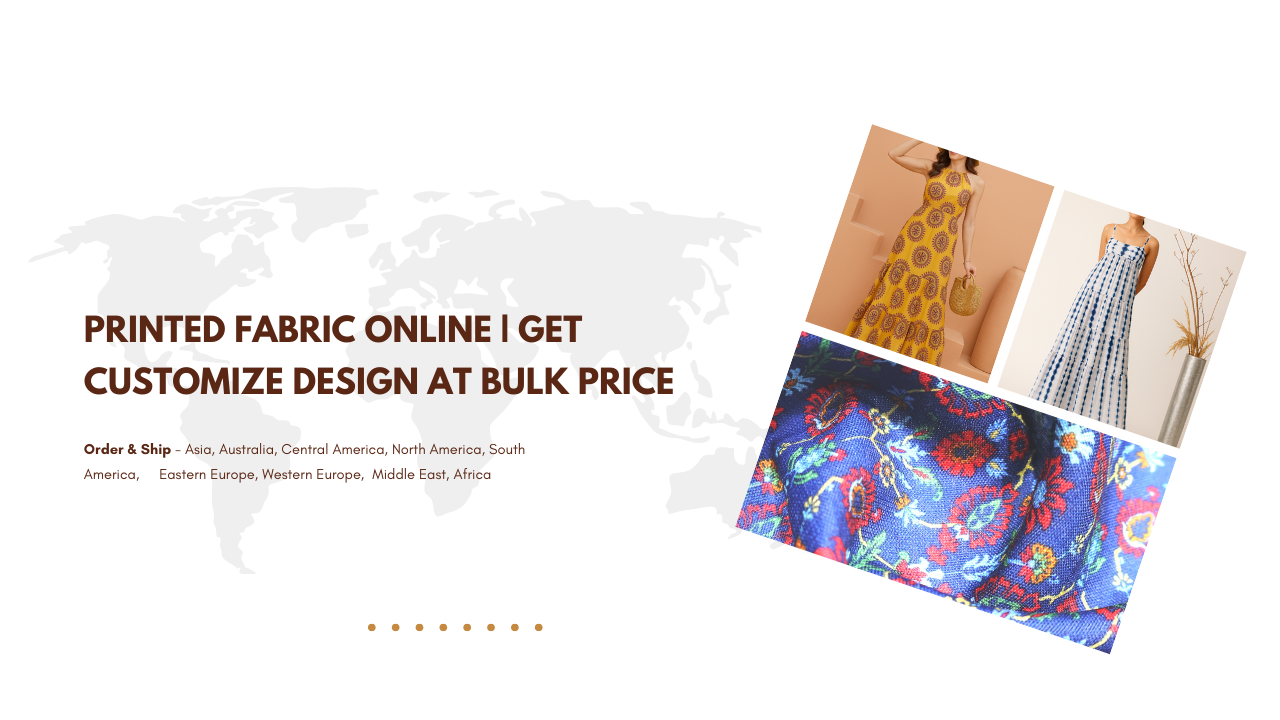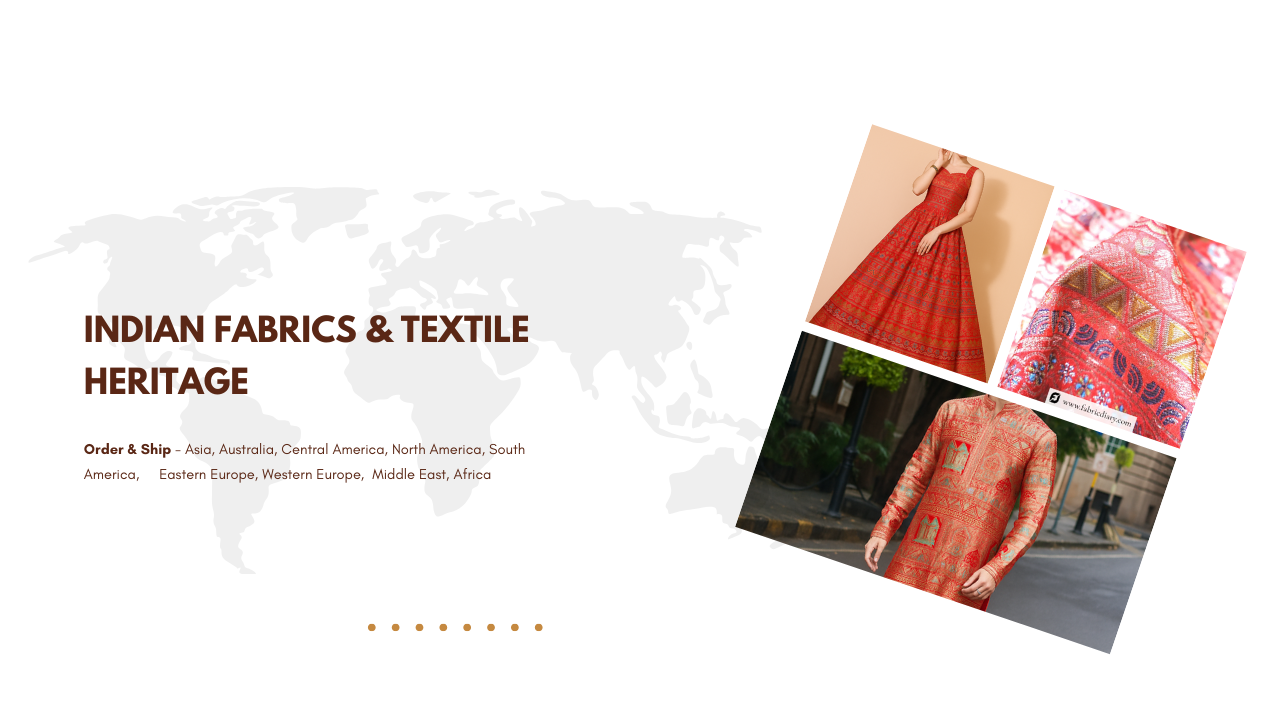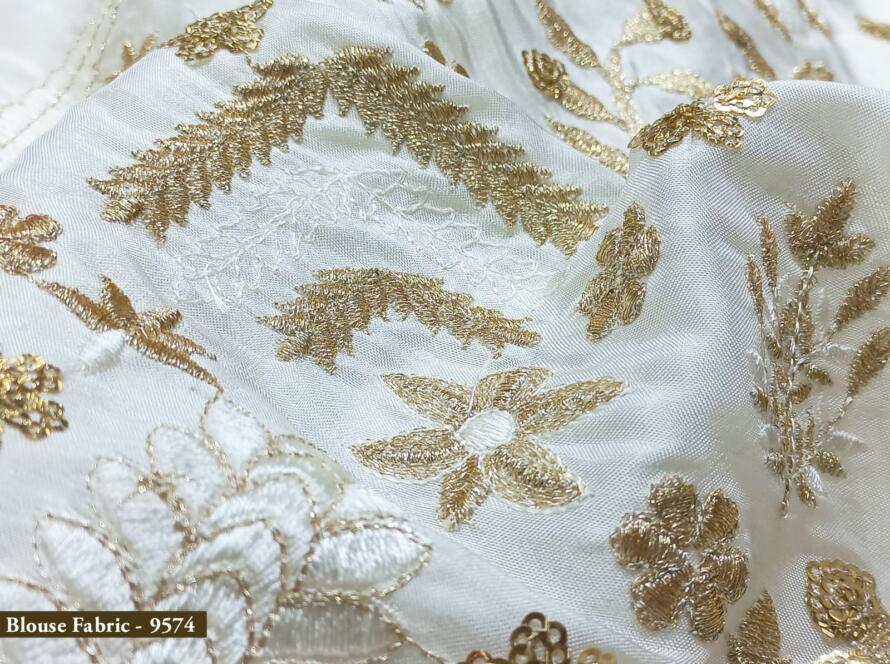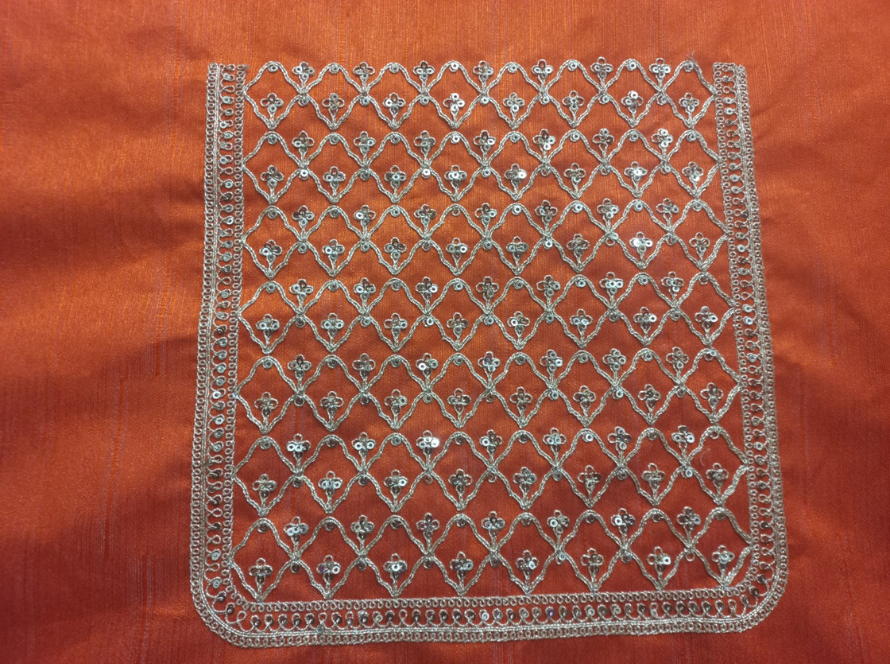Embroidery fabrics have long been a symbol of luxury, craftsmanship, and heritage. From traditional handmade designs to modern machine-embroidered patterns, these fabrics are widely used in fashion, bridal wear, and interior decor. Whether you’re a designer, fashion enthusiast, or textile business owner, understanding embroidery fabrics can help you make the right choice.
In this guide, we will explore the best embroidery fabrics in the world, their evolution across different cultures, and top trends for 2025. Plus, we’ll help you decide between handmade vs machine embroidery and how to select the best embroidery fabric for dresses.
Best Embroidery Fabrics in the World – A Guide by Madhav Fashion
The Evolution of Embroidery Fabrics Across the World
Embroidery is an ancient art form with deep cultural significance in various countries:
- India: Chikankari, Zardosi, Phulkari, Kantha – Known for rich handwork on silk, cotton, and velvet.
- China: Suzhou embroidery, silk embroidery – Famous for detailed, silk-threaded designs.
- France: Broderie Anglaise, Haute Couture embroidery – Delicate patterns used in luxury fashion.
- Middle East: Gold thread embroidery, Kashmiri embroidery – Luxurious handcrafted work on fine fabrics.
- Europe: Lace embroidery, machine embroidery – Used extensively in wedding gowns and high fashion.
Embroidery has evolved from handcrafted designs to advanced machine embroidery, offering limitless design possibilities while preserving its heritage.
Best Embroidery Fabrics in the World: A Global Textile Revolution
The demand for Best Embroidery Fabrics in the World is rising as designers and fashion houses seek premium textiles for couture and ethnic wear. From India’s Zardosi to France’s Broderie Anglaise, the Best Embroidery Fabrics in the World are redefining luxury fashion.
Experts predict that in 2025, sustainable and handcrafted textiles will dominate the list of Best Embroidery Fabrics in the World. Silk, velvet, and organza remain favorites, while AI-designed embroidery is pushing innovation. Brands sourcing the Best Embroidery Fabrics in the World focus on both craftsmanship and machine precision.
Fashion designers globally prefer the Best Embroidery Fabrics in the World for wedding gowns, red-carpet outfits, and traditional attire. Textile businesses are witnessing a surge in demand, with the Best Embroidery Fabrics in the World becoming a top priority for retailers.
For those looking to invest in high-quality textiles, Best Embroidery Fabrics in the World from trusted suppliers like Madhav Fashion ensure luxury and durability. As embroidery trends evolve, the Best Embroidery Fabrics in the World continue to inspire creativity and excellence in fashion.
Types of Embroidery Fabrics
When choosing an embroidery fabric, understanding the base material is crucial. Here are some of the most commonly used fabrics:
- Cotton: Lightweight and breathable, perfect for delicate embroidery.
- Silk: Luxurious and smooth, widely used in high-end fashion.
- Linen: Strong, natural, and durable for handcrafted embroidery.
- Velvet: Rich texture, ideal for royal and premium embroidery designs.
- Organza & Net: Lightweight and sheer, often used in bridal and couture designs.
These fabrics are the backbone of the embroidery industry, influencing fashion designers and textile businesses worldwide.
Why Embroidery Fabrics Are Loved Globally?
Embroidery fabrics remain popular worldwide due to their timeless appeal and versatility:
- Luxurious & Elegant: Adds sophistication to any outfit or décor.
- Highly Customizable: Designers can create unique, personalized patterns.
- Durability & Longevity: Embroidered fabrics last longer with proper care.
- Traditional Meets Modern: Handcrafted designs combined with modern techniques for a unique look.
From red carpet fashion to traditional ethnic wear, embroidery fabrics continue to define elegance.
Handmade vs Machine Embroidery Fabric – Which One to Choose?
A common debate in the textile world is handmade vs machine embroidery fabric. Let’s break it down:
FeatureHandmade EmbroideryMachine EmbroideryCraftsmanshipUnique, artisan-madeMass-produced with precisionDetailingIntricate & time-consumingUniform & fast productionCustomizationFully customizableLimited to machine patternsPricingMore expensive due to laborMore affordable in bulk
If you prefer authentic, artistic, and premium embroidery, go for handmade embroidery fabric. But for quick production and cost-effectiveness, machine embroidery fabrics are the best choice.
Top Trends in Embroidered Fabrics (2025 Edition)
As we step into 2025, here are the biggest trends in embroidery fabrics:
- 3D Embroidery Designs: Raised embroidery for a more dynamic and modern look.
- Sustainable Embroidery Fabrics: Organic cotton, recycled silk, and eco-friendly threads.
- Metallic Embroidery: Gold and silver threads for a luxurious appeal.
- AI-Designed Embroidery: Digital precision patterns powered by AI.
- Hand-Painted & Embroidered Fusion: A mix of artistic hand-painting with embroidery work.
These trends are shaping the global embroidery fabric market, offering new possibilities for designers and textile brands.
How to Choose the Best Embroidery Fabric for Dresses?
If you are selecting an embroidery fabric for fashion or special occasions, keep these tips in mind:
- Purpose: Wedding wear? Casual wear? Home décor? Choose accordingly.
- Fabric Strength: Delicate fabrics like net require softer embroidery, while silk and velvet can hold heavier work.
- Thread Quality: Opt for fine silk or metallic threads for a premium look.
- Season & Comfort: Cotton and linen for summers, velvet and silk for winters.
- Design & Customization: Ensure the embroidery design complements the outfit style.
For premium, designer embroidery fabrics, quality is key. This is where Madhav Fashion comes in.
Madhav Fashion – Your Trusted Source for Embroidery Fabrics
At Madhav Fashion, we bring you premium quality embroidery fabrics, blending traditional craftsmanship with modern designs. Our collection includes:
- Luxury embroidery materials for designer wear.
- Handmade & machine-embroidered fabrics for all fashion needs.
- Global shipping to fashion houses and boutique owners worldwide.
From high-end couture to ethnic and bridal fashion, Madhav Fashion is your go-to brand for embroidery fabrics.
Explore the Best Embroidery Fabrics with Madhav Fashion
Looking for exclusive embroidery fabrics? Visit Madhav Fashion today and discover a world of luxurious, high-quality embroidered textiles.
Let art meet elegance with the finest designer embroidery fabrics in the world.
________________________________
What Are the Best Embroidery Fabrics for Different Types of Embroidery?
Choosing the right fabric is crucial for achieving the best embroidery results. The best embroidery fabrics vary depending on the embroidery type:
- For Hand Embroidery: Cotton, linen, and silk are ideal due to their tight weave and durability. These fabrics allow detailed needlework and hold stitches well.
- For Machine Embroidery: Polyester blends, organza, and velvet work best because they provide a smooth surface for automated stitching.
- For Heavy Embroidery (Zardosi, Aari, or Goldwork): Silk, velvet, and wool are the best choices, as they provide strong backing for intricate and heavy designs.
- For Lightweight and Sheer Embroidery: Chiffon, organza, and georgette require stabilizers to support delicate needlework.
Selecting the right embroidery fabric depends on the intended design, technique, and final use. Luxury embroidery materials like silk and velvet are preferred for high-end fashion, while cotton and linen are commonly used for casual and everyday embroidery projects. At Madhav Fashion, we offer a wide variety of embroidery fabrics, ensuring that artisans and designers can find the perfect base material for their creative projects.
What Is the Difference Between Handmade and Machine Embroidered Fabrics?
Handmade and machine-embroidered fabrics both have their own unique appeal. Here’s how they differ:
- Craftsmanship: Handmade embroidery involves skilled artisans using traditional techniques, making each piece unique. Machine embroidery, on the other hand, is automated and produces uniform patterns.
- Detailing: Handmade embroidery can feature intricate details and 3D effects, while machine embroidery offers precision but may lack the personal touch of handcrafted work.
- Customization: Handmade embroidery allows unlimited creativity and design flexibility. Machine embroidery, although customizable, is limited by digital programming.
- Durability: Handmade embroidery is often more delicate but highly valued for its artistic and cultural significance. Machine embroidery is durable and better suited for mass production.
- Cost: Due to labor and craftsmanship, handmade embroidery is more expensive. Machine embroidery is more affordable and widely available.
Both types have their place in the fashion and textile industry. If you seek exclusivity and craftsmanship, handmade embroidery is ideal. For mass production and cost-effective designs, machine embroidery is the better choice. Madhav Fashion provides high-quality handmade and machine-embroidered fabrics, catering to diverse customer needs.
How Do Fashion Designers Use Embroidery Fabrics in the Global Fashion Industry?
Embroidery fabrics play a vital role in global fashion, used by leading designers for luxury wear, haute couture, and traditional attire. Fashion houses incorporate embroidery in the following ways:
- Haute Couture: Luxury brands like Chanel, Dior, and Valentino use embroidered fabrics in their high-fashion collections.
- Bridal Wear: Indian, Middle Eastern, and Western bridal designers rely on rich embroidered fabrics like Zardosi, lace, and beaded tulle to craft elegant wedding gowns.
- Ethnic and Traditional Wear: Embroidery techniques such as Chikankari, Phulkari, and Kashmiri work are integral to Indian, Pakistani, and Middle Eastern fashion.
- Red Carpet Fashion: Celebrities often wear embroidered gowns and suits on red carpets, showcasing craftsmanship through metallic embroidery, beadwork, and 3D embroidery.
- Sustainable Fashion: Many designers now opt for eco-friendly, hand-embroidered fabrics using organic cotton and recycled threads.
The demand for embroidery fabrics continues to grow as designers seek exclusive and high-quality materials. Madhav Fashion offers premium embroidery fabrics that meet the standards of global fashion designers.
What Are the Latest Trends in Embroidered Fabrics for 2025?
Embroidery fashion evolves constantly, and 2025 is seeing new and exciting trends:
- 3D Embroidery: Raised threadwork gives designs a sculptural look.
- Metallic Threads: Gold and silver embroidery are being widely used in contemporary couture.
- AI-Designed Embroidery: Machine learning is allowing complex, highly precise embroidery designs.
- Sustainable Embroidery: Eco-friendly threads, organic cotton, and recycled materials are being adopted.
- Fusion of Hand-Painted and Embroidery Work: Designers are combining hand-painted designs with embroidered accents.
- Minimalist Embroidery: Simple yet elegant embroidery is trending in everyday wear and office fashion.
- Ethnic Revival: Traditional embroidery styles like Kantha, Phulkari, and Suzhou embroidery are making a global comeback.
At Madhav Fashion, we stay ahead of these trends, offering a collection that aligns with the latest innovations in embroidery textiles.
How Do I Maintain and Care for Embroidery Fabrics?
Proper care ensures longevity for embroidery fabrics:
- Hand Washing: Delicate embroidered fabrics should be hand-washed in cold water with mild detergent.
- Machine Wash (if allowed): Use a gentle cycle with the fabric inside a mesh bag.
- Drying: Air dry embroidery fabrics to prevent damage from high heat.
- Ironing: Use a low-heat setting with a cloth over the embroidery to avoid thread damage.
- Storage: Store embroidered garments flat or rolled to prevent creases and thread pulling.
By following these steps, embroidery fabrics can retain their beauty for years. Madhav Fashion offers high-quality embroidery fabrics designed for durability and ease of maintenance.
What Are the Most Expensive Embroidery Fabrics in the World?
Luxury embroidery fabrics are priced based on craftsmanship, material, and exclusivity. Some of the most expensive embroidery fabrics include:
- Handwoven Silk with Gold Zari Embroidery (India, Middle East)
- French Lace with Embroidery and Beadwork (France)
- Kashmiri Pashmina Embroidery (India)
- Hand-Beaded Velvet with Swarovski Crystals
- Bespoke Couture Embroidery on Organza
These fabrics are commonly used in royal fashion, haute couture, and high-end bridal wear. Madhav Fashion offers premium embroidery fabrics that balance luxury and affordability.
How Can Businesses and Boutiques Source Quality Embroidery Fabrics?
For businesses looking for embroidery fabrics, these tips help in sourcing the best materials:
- Work with Reputed Suppliers: Choose experienced brands like Madhav Fashion for quality assurance.
- Check Fabric Quality: Look for strong weaves, smooth finishes, and colorfast threads.
- Request Samples: Always test embroidery fabrics before bulk purchasing.
- Look for Customization Options: Custom embroidery designs can set a business apart.
- Consider Global Shipping & Logistics: Ensure the supplier offers international delivery.
At Madhav Fashion, we specialize in providing premium embroidery fabrics to designers, retailers, and boutiques worldwide.
What Are the Best Embroidery Fabrics for Home Décor?
Embroidery fabrics are widely used in home interiors:
- Cushion Covers & Throws: Velvet, cotton, and jacquard embroidery fabrics.
- Curtains & Drapes: Sheer embroidered organza or heavy silk embroidery.
- Table Runners & Placemats: Linen and cotton embroidery with intricate patterns.
- Wall Hangings & Tapestries: Hand-embroidered wool or silk-based fabrics.
Using embroidery fabrics in home décor adds luxury and artistic appeal. Madhav Fashion provides high-quality embroidered textiles for both fashion and interior design.
Why Choose Madhav Fashion for Embroidery Fabrics?
Madhav Fashion is a trusted name in the embroidery fabric industry. We offer:
- A diverse collection of handmade and machine embroidery fabrics.
- Customization services for designers and businesses.
- High-quality materials sourced from the best mills.
- Global shipping for worldwide customers.
Whether for couture fashion, ethnic wear, or home interiors, Madhav Fashion provides premium embroidery fabrics to meet every need.


